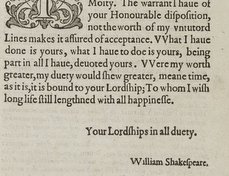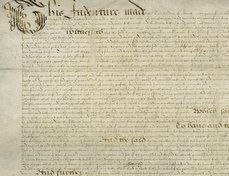© Copyright David Cooper used with the permission of Dulwich College.
Terms of use
Dulwich College has graciously contributed images from their collections to Shakespeare Documented, and retains sole ownership of said images. Visitors may link to and cite the images within Shakespeare Documented in personal research only. Any further use, including, but not limited to, unauthorized downloading or distribution of the images is strictly prohibited. Visitors must contact Dulwich College to request additional use, at: archives@dulwich.org.uk
Document-specific information
Date: 1592-94
Repository: Dulwich College, London, UK
Call number and opening: Henslowe diary, MSS 7 fols. 7r-9r
View in Henslowe-Alleyn Digitisation Project
Grace Ioppolo, "Henslowe's diary: including the first recorded performances of Henry VI and Titus Andronicus, and a possible performance of The Taming of the Shrew," Shakespeare Documented, https://doi.org/10.37078/553.
Dulwich College, Henslowe diary, MSS 7. See Shakespeare Documented, https://doi.org/10.37078/553.
The entrepreneur Philip Henslowe’s unique “Diary,” or account book, of his extensive theatrical enterprises records the titles of over 325 plays from 1592 to 1604, including two, perhaps three, plays written in part or whole by Shakespeare: Henry VI Part 1, Titus Andronicus, and The Taming of the Shrew.
Henslowe and his son-in-law, the great actor Edward Alleyn, built and expanded several London public playhouses, including the Rose, the Fortune, and the Hope (the foundations of some of which have recently been discovered or excavated by Museum of London staff). Named by King James I as joint “Masters of the Royal Game of Bears, Bulls and Mastiff Dogs,” Henslowe and Alleyn also staged such blood sports as bull-, bear-, and lion-baiting at the Bear Garden and other venues, including royal palaces. Henslowe and Alleyn also commissioned plays from dramatists and ran several of the most successful acting companies of the time, including the Lord Strange’s Men and the Lord Admiral’s Men, for which Alleyn performed such famous roles as Dr. Faustus and Tamburlaine.
As R. A. Foakes noted in his 2002 edition of Henslowe’s Diary (p. xxviii), Philip Henslowe made four type of entries in his account book that related to the theater profession:
- daily receipts that he took from play performances from February 19, 1592 to November 5, 1597
- expenditures on behalf of the Lord Admiral’s or Earl of Worcester’s Men from October 21, 1597 to March 14, 1604, including commissioning plays from dramatists
- payments for the construction and repair of two playhouses: the Rose (built 1587) and the Fortune (built 1600)
- notes on hiring actors, payments to the Master of the Revels, various legal proceedings and other miscellaneous transactions
The first type of entry, payments for numerous plays, including the only known box-office receipts for Shakespearean plays, appears on folios 7 recto to 9 recto of the Diary.
On folios 7 recto - 8 verso, Henslowe noted receipts for sixteen performances of “harey vj” by the Lord Strange’s Men in 1592 at the Rose on March 3, 7, 11, 16, and 28; April 5, 13 and 21; May 4, 7, 14, 19, 25, and June 12 and 19; and in 1594 on January 16. Judging from its composition by about early 1592, this is probably the play we know as Henry VI Part 1. Shakespeare wrote Part 1 after writing or co-writing Henry VI Part 2 and Part 3, originally titled in their first quartos and probably performed as The First Part of the Contention Between the Two Houses of York and Lancaster (1594) and The True Tragedy of Richard Duke of York (1595), respectively.
For the performances of Henry VI Part I, Henslowe recorded earnings ranging from 3 pounds, 16 shillings, 8 pence when the play was “ne” (new) in 1592, to 22 shillings, later in its run. Although we have no evidence that Shakespeare was ever a member of Lord Strange’s Men, companies he wrote for or performed with before he became a sharer in the Lord Chamberlain’s Men in 1594 occasionally performed with other companies, possibly including the Lord Strange’s Men.
On folios 8 verso and 9 recto, Henslowe noted receipts for three performances of Titus Andronicus by the Earl of Sussex’s Men at the Rose on January 23 and 28, and February 6, 1594. The February performance date was the same day the play was entered into the Stationers’ Register. The first edition of the play was printed later in 1594. Henslowe noted two additional performances by the Lord Chamberlain’s Men playing with the Lord Admiral’s Men on June 5 and 12 at Newington Butts, when the Rose was closed due to plague. Henslowe’s earnings for these five performances varied from as little as 7 shillings, up to 3 pounds, 8 shillings at its first performance when he also listed it as “ne.”
On folio 9 recto, Henslowe noted receipts of 9 shillings for a single performance of “the tamynge of A shrowe” on June 11, 1594. This is probably Shakespeare’s The Taming of the Shrew, as it is among the plays also listed as performed by the Lord Admiral’s Men playing together or in tandem with the Lord Chamberlain’s Men, Shakespeare’s company. This “shrowe” may also refer to the play The Taming of a Shrew published anonymously in 1594 as performed by the Earl of Pembroke’s Men, which may have been a source, analogue or mangled version of Shakespeare’s play, first published in the 1623 First Folio.
That Henslowe recorded larger receipts for some plays than for others does not necessarily mean that profits equated to popularity or even success. Several factors could influence the profits for any given performance. To begin with, a number of overhead expenses, including rent, taxes and other required payments varied from day-to-day and affected Henslowe’s share of the profits for performances. In addition, as argued by Scott McMillin and Sally-Beth MacLean, the history play was the most popular theatrical genre in the 1590s, which would explain why “harey vj” was performed so often and was in fact written as a prequel to two other plays. Lastly, by about 1600, particular playwrights, including Shakespeare and Jonson, developed a kind of cult of celebrity, as play quarto title pages began to note the authors’ names. Earlier play quarto title pages, including the 1594 editions of Titus Andronicus and The Taming of a Shrew, did not feature the author’s name and usually treated acting companies as the celebrities, featuring their names prominently. Thus Henslowe’s higher earnings for particular plays in the early 1590s may have reflected performances featuring Alleyn, Richard Burbage or other actors in particular prominent companies, not famous playwrights. In fact, plays listed as “ne” did not always produce the largest receipts for Henslowe.
Henslowe success eventually allowed him to not just share in acting companies’ profits, but to finance them and to commission new plays by an increasingly large cohort of authors. He would spend the rest of his career, until the day of his death on January 6, 1616, investing in every possible business allied to theater production and performance, dying a very rich man.
Written by Grace Ioppolo
Sources
R. A. Foakes and R. T. Rickert, Henslowe’s Diary (Cambridge University Press, 1961; rpt. 2002).
W. W. Greg, The Henslowe Papers (A. H. Bullen, 1907).
Henslowe-Alleyn Digitisation Project
Grace Ioppolo. Dramatists and their Manuscripts in the Age of Shakespeare, Jonson, Middleton and Heywood: Authorship, Authority and the Playhouse. (Routledge, 2006).
Scott McMillin and Sally-Beth MacLean, The Queen’s Men and Their Plays (Cambridge University Press, 1998).
George F. Warner, Catalogue of the Manuscripts and Muniments of Alleyn’s College of God’s Gift at Dulwich (Longmans, Green, and Co., 1881).
Last updated September 19, 2020














